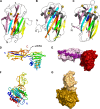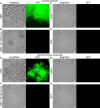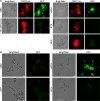Aeromonas hydrophila RTX adhesin has three ligand-binding domains that give the bacterium the potential to adhere to and aggregate a wide variety of cell types
- PMID: 40243363
- PMCID: PMC12077191
- DOI: 10.1128/mbio.03158-24
Aeromonas hydrophila RTX adhesin has three ligand-binding domains that give the bacterium the potential to adhere to and aggregate a wide variety of cell types
Abstract
Bacteria often make initial contact with their hosts through the ligand-binding domains of large adhesin proteins. Recent analyses of repeats-in-toxin (RTX) adhesins in Gram-negative bacteria suggest that ligand-binding domains can be identified by the way they emerge from "split" domains within the adhesin. Here, using this criterion and an AlphaFold3 model of a 5047-residue RTX adhesin from Aeromonas hydrophila, we identified three different ligand-binding domains in this fibrillar protein. The crystal structures of the two novel domains were solved to 1.4 and 1.95 Å resolution, respectively, and demonstrate excellent agreement with their modeled structures. The other domain was recognized as a carbohydrate-binding module based on its beta-strand topology and confirmed by its micromolar affinity for fucosylated glycans, including the Lewis B and Y antigens. This lectin-like module, which was recombinantly produced with its companion split domain and nearby extender domain, bound to a wide variety of cells including yeasts, diatoms, erythrocytes, and human endothelial cells. In each case, 50 mM free fucose prevented this binding and may offer some protection from infection. The carbohydrate-binding module with its neighboring domains also caused aggregation of yeast and erythrocytes, which was again blocked by the addition of free fucose. The second putative ligand-binding domain has a beta-roll structure supported by a parallel alpha-helix, and the third is a homolog of a von Willebrand Factor A domain. These two domains bind to a more limited range of cell types, and their ligands have yet to be identified.IMPORTANCECharacterizing the ligand-binding domains of fibrillar adhesins is important for understanding how bacteria can colonize host surfaces and how this colonization might be blocked. Here, we show that the opportunistic pathogen, Aeromonas hydrophila, uses a carbohydrate-binding module (CBM) to attach to several different cell types. The CBM is one of three ligand-binding domains at the distal tip of the adhesin. Identifying the glycans bound by the CBM as Lewis B and Y antigens has helped explain the range of cell types that the bacterium will bind and colonize, and it has suggested sugars that might interfere with these processes. Indeed, fucose, which is a constituent of the Lewis B and Y antigens, is effective at 50 mM concentrations in blocking the attachment of the CBM to host cells. This will lead to the design of more effective inhibitors against bacterial infections.
Keywords: Aeromonas; adhesins; antimicrobial agents; binding proteins; biofilms; protein structure–function; receptor–ligand interaction.
Conflict of interest statement
The authors declare no conflict of interest.
Figures









Similar articles
-
Adhesin domains responsible for binding bacteria to surfaces they colonize project outwards from companion split domains.Proteins. 2024 Aug;92(8):933-945. doi: 10.1002/prot.26689. Epub 2024 Apr 9. Proteins. 2024. PMID: 38591850
-
Sugar-binding and split domain combinations in repeats-in-toxin adhesins from Vibrio cholerae and Aeromonas veronii mediate cell-surface recognition and hemolytic activities.mBio. 2024 Feb 14;15(2):e0229123. doi: 10.1128/mbio.02291-23. Epub 2024 Jan 3. mBio. 2024. PMID: 38171003 Free PMC article.
-
Structural Basis of Ligand Selectivity by a Bacterial Adhesin Lectin Involved in Multispecies Biofilm Formation.mBio. 2021 Apr 6;12(2):e00130-21. doi: 10.1128/mBio.00130-21. mBio. 2021. PMID: 33824212 Free PMC article.
-
RTX Adhesins are Key Bacterial Surface Megaproteins in the Formation of Biofilms.Trends Microbiol. 2019 May;27(5):453-467. doi: 10.1016/j.tim.2018.12.003. Epub 2019 Jan 15. Trends Microbiol. 2019. PMID: 30658900 Review.
-
Molecular structure of adhesin domains in Escherichia coli fimbriae.Int J Med Microbiol. 2005 Oct;295(6-7):479-86. doi: 10.1016/j.ijmm.2005.06.010. Int J Med Microbiol. 2005. PMID: 16238022 Review.
Cited by
-
AlphaFold 3: an unprecedent opportunity for fundamental research and drug development.Precis Clin Med. 2025 Jul 1;8(3):pbaf015. doi: 10.1093/pcmedi/pbaf015. eCollection 2025 Sep. Precis Clin Med. 2025. PMID: 40799364 Free PMC article. Review.
References
-
- Zepeda-Velazquez AP, Gómez-De-Anda F-R, Aguilar-Mendoza LF, Castrejón-Jiménez NS, Hernández-González JC, Varela-Guerrero JA, de-la-Rosa-Arana J-L, Vega-Sánchez V, Reyes-Rodríguez NE. 2023. Bullfrogs (Lithobates catesbeianus) as a potential source of foodborne disease. J Food Prot 86:100067. doi:10.1016/j.jfp.2023.100067 - DOI - PubMed
MeSH terms
Substances
Grants and funding
LinkOut - more resources
Full Text Sources

